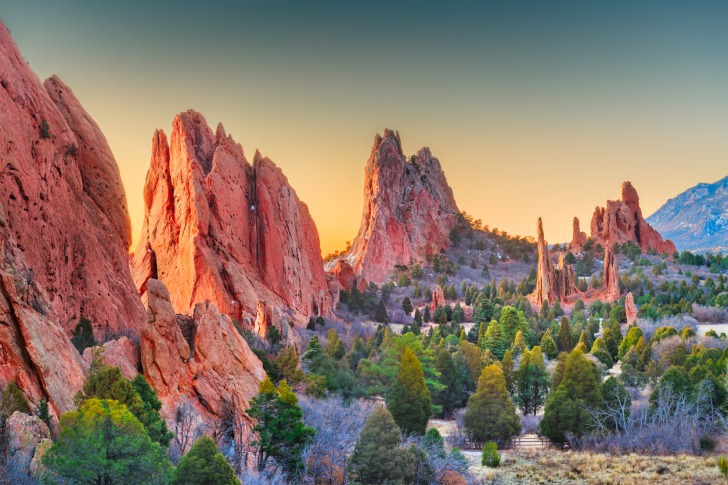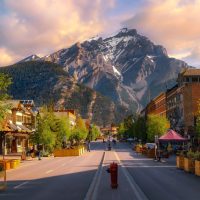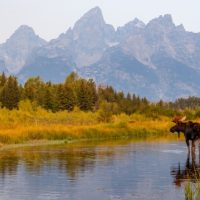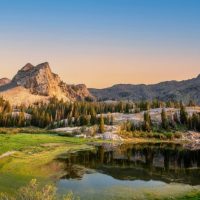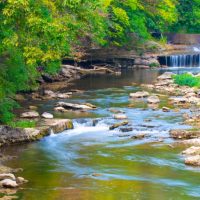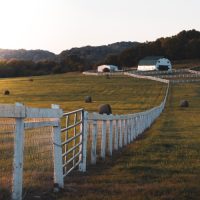When you think of Colorado, no doubt images of snow-capped mountains come to mind.
However, the state consists of plenty of prairies, where this western state’s most dangerous snakes easily hide, ready to attack their next victim.
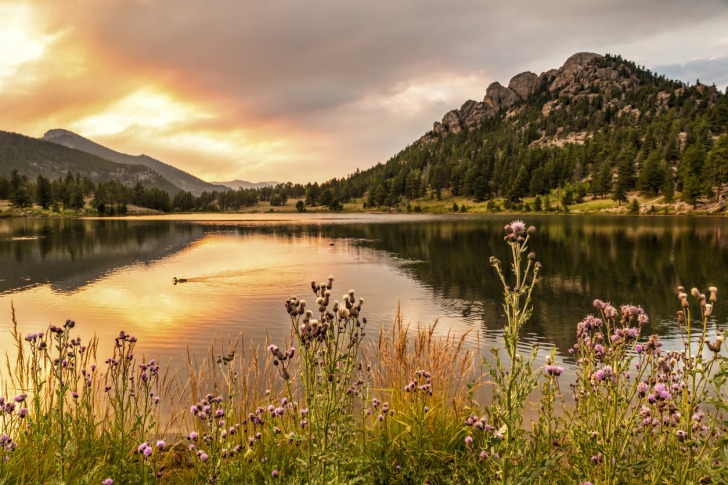
Contents
- So… Are There Snakes in Colorado?
- Snake Species in Colorado
- Prairie Rattlesnake
- Midget Faded Rattlesnake
- Western Massasauga Rattlesnake
- Black Neck Garter Snake
- Texas Blind Snake
- Bull Snake
- Western Milksnake
- Coachwhip
- Common Garter Snake
- Speckled Kingsnake
- Glossy Snake
- Great Basin Gopher Snake
- Great Plains Rat Snake
- Ground Snake
- Lined Snake
- Longnose Snake
- Texas Night Snake
- Northern Water Snake
- Plains Blackhead Snake
- Plains Garter Snake
- Ringneck Snake
- Smooth Green Snake
- Southwestern Blackhead Snake
- Striped Whipsnake
- Striped Hognose
- Western Terrestrial Garter Snake
- Yellow-Bellied Racer
- Is it Safe to Go on a Trek in Colorado?
- Interesting Snake Facts in Colorado
- 3 Safety Tips for Exploring Nature in Colorado
- Summary
- Colorado Safety Overview
- Frequently Asked Questions
So… Are There Snakes in Colorado?
Colorado has close to 30 species of snakes.
Thankfully, only three kinds are venomous to humans, all in the rattlesnake family.
Snake Species in Colorado
The venomous Colorado snakes include three types of rattlesnakes:
- Prairie rattlesnake
- Midget faded rattlesnake
- Western Massasauga rattlesnake
Prairie Rattlesnake
The prairie rattlesnake inhabits most of Colorado and is part of the pit viper family.
They have a potent venom but rarely kill humans since the snake’s size is usually too small to deliver a lethal dose.
Midget Faded Rattlesnake
This rattlesnake breed is considered small, hence the name.
They grow to an adult size of 20 to 30 inches.
Western Massasauga Rattlesnake
Their camouflage coloring hides them in grass where they are difficult to spot.
The Massasauga snake venom contains an enzyme that disrupts blood flow, stopping clotting and destroying tissues in its victims.
Other Colorado snakes include the following:
- Black neck garter snake
- Texas blind snake
- Bull snake
- Western milksnake
- Coachwhip
- Common garter snake
- Speckled kingsnake
- Glossy snake
- Great basin gopher snake
- Great plains rat snake
- Ground snake
- Lined snake
- Longnose snake
- Texas night snake
- Northern water snake
- Plains blackhead snake
- Plains garter snake
- Ringneck snake
- Smooth green snake
- Southwestern blackhead snake
- Striped whipsnake
- Western hognose
- Western terrestrial garter snake
- Yellow-bellied racer
Black Neck Garter Snake
The black pattern on both sides of its neck contributed to its name.
The blackneck garter snake lives in grasslands near water and is the rarest species in Colorado.
Texas Blind Snake
Also called thread snake, this snake is pinkish brown with shiny scales.
People often mistake it as an earthworm.
Bull Snake
Bull snakes in Colorado grow up to 88 inches, dwelling in grasslands, open woodlands, and farmlands.
They are yellowish with reddish-brown to black blotches on their back.
Western Milksnake
This snake has smooth, shiny scales with a white, cream, or light gray body covered with wide red blotches outlined in black.
Find them under rocks, on rocky ledges, under logs, or in forests, woodland, pastures, and the plains of Colorado.
Coachwhip
The coachwhip snake gets its name from the braided appearance of its yellowish-brown scales and slender body.
Some appear burgundy.
Find them in open grassland prairies.
Common Garter Snake
This snake has three yellow body stripes on each side of its body with a row of small dark spots on the edges.
They dwell in almost any moderately wet area.
Speckled Kingsnake
These snakes have smooth scales with a yellow belly, an irregular pattern of black, a black head, and a speckled body.
Find them in grasslands and plains or rocky ledges.
Glossy Snake
This snake looks glossy with dark gray or brown blotches and a white belly.
They dwell in grasslands and sand or loose soil.
Great Basin Gopher Snake
This snake has dark brown or black spots connected by narrow lines along the side of their body.
They defend themselves by mimicking a rattlesnake.
Great Plains Rat Snake
This snake lives at 6000 feet or below elevations, preferring plains and grasslands.
They feed on rodents and are light gray with dark outlined blotches down their backs and stripes on the side of their head.
Ground Snake
Find these snakes in sand or loose soil.
They have smooth scales with different patterns.
Some are reddish brown, gray, or have black crossbands.
Lined Snake
Find this snake under rocks, in open prairies, along woodland edges, or on hillsides.
People often mistake it for a garter snake.
Longnose Snake
This snake’s body is yellowish-cream with black blotches and reddish-pink spaces in between.
It likes open prairies or sandy spots under rocks and on canyon slopes.
Texas Night Snake
This snake prefers prairies and grasslands.
It has smooth scales that are gray or grayish-yellow with dark brown blotches.
Northern Water Snake
Spot one near water hiding in branches or piles of debris basking on the shore.
Their color varies from brown, reddish, gray, or black with dark crossbands or blotches.
Plains Blackhead Snake
This snake has smooth scales with a dark head.
The body and tail look light yellowish-brown.
They dwell throughout the eastern slope of Colorado and in the plains and grasslands.
Plains Garter Snake
Look for a single stripe down the middle of its back and on each side of the body, alternating rows of black spots in between.
It dwells along the edges of water and in open grassy prairies.
Ringneck Snake
This nocturnal snake dwells in moist soil or under cover and is mildly venomous.
The color varies from slate gray, brown, bluish gray, or olive, with a yellow to orange ring around their neck.
They coil to display their red when threatened.
Smooth Green Snake
Find smooth green snakes in meadows, marshes, streams, or the open woods.
They are slender green snakes with hints of yellow and like to bask in the sun by rocks.
Southwestern Blackhead Snake
Look for smooth scales and a dark head with a light brown tail.
Find them under rocks on the western slope of Colorado.
Striped Whipsnake
This snake is black, gray, or dark brown and usually has an olive or bluish tint.
Find them in the western slope of Colorado in shrubs, brush, canyons, or woodlands.
Striped Hognose
They have a distinct upturned and pointed snout.
Look for dark blotches on its yellowish back.
This snake lives in prairies and prefers loose and sandy soil for burrowing.
Western Terrestrial Garter Snake
This snake looks brown or gray with a light tan checkerboard pattern.
Find these snakes in many areas, including moist environments or woodlands.
Yellow-Bellied Racer
This snake has smooth scales and a cream or yellow belly.
The upper body is greenish-blue, brown, or bluish-gray.
Find them in rocky wooded hillsides, pastures, or prairies.
Is it Safe to Go on a Trek in Colorado?
If you follow precautions, feel safe venturing out on a hiking trek in Colorado.
Always be aware of potential dangers and take steps to stay safe.
If you decide to trek in the mountains, be aware that altitude sickness is common.
Those not used to altitudes above 5,000 feet are susceptible.
Acclimate yourself to the altitude by spending a few days in the mountains before going out for a hike.
Understand potentially dangerous wildlife.
Watch for venomous snakes.
Also, stay vigilant of other dangers, such as bears.
Minimize your risks by staying on designated trails.
Always pay attention to your surroundings and obey all posted signs.
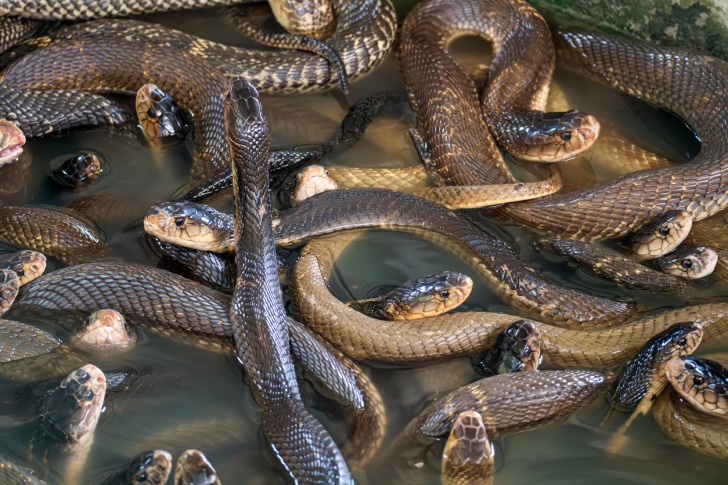
Interesting Snake Facts in Colorado
Some non-venomous snakes have the same markings or behavior as a rattlesnake, which makes it difficult to tell them apart.
Snakes play a vital role in the ecosystem.
Most snake bites occur because someone tried to prod or provoke a snake.
3 Safety Tips for Exploring Nature in Colorado
Some potential dangers of exploring nature in Colorado include altitude sickness, hypothermia, getting injured, being struck by lightning or caught in a flash flood due to Colorado’s rapidly changing weather, falling, or encountering dangerous wildlife.
Stay safe when you plan on exploring nature in Colorado by following these three important safety tips:
- Make a plan. Before venturing out on your own, notify someone, check the weather forecast, pack all the essentials, including a first aid kit and plenty of water and food, and dress appropriately in close-toed shoes and long pants.
- Go with a guide. If you’ve never explored the area, don’t do it alone. Go with an experienced guide.
- Respect nature by disposing of your trash properly and take responsibility when camping with a campfire. Never feed wild animals, and learn about any dangerous wildlife you may encounter.
Summary
Colorado is beautiful to explore when you understand potential dangers, such as snakes and other wildlife.
Even though the state has numerous varieties of snakes, only three pose a real threat to humans.
Colorado Safety Overview
READ THE FULL REPORT: Colorado Safety Review
Safety Index:
- OVERALL RISK: LOW
- TRANSPORT & TAXIS RISK: LOW
- PICKPOCKETS RISK: LOW
- NATURAL DISASTERS RISK: MEDIUM
- MUGGING RISK: LOW
- TERRORISM RISK: LOW
- SCAMS RISK: LOW
- WOMEN TRAVELERS RISK: LOW
Frequently Asked Questions
How many people die every year from snake bites in Colorado?
According to national statistics, about 200 reported venomous snake bites occur every year in Colorado.
Of this number, very few have died from snake bites.
According to the CDC, in the United States, only about five deaths occur from snake bites annually.
What snakes are dangerous in Colorado?
Only three types of snakes are considered dangerous to humans in Colorado.
All three belong to the rattlesnake family.
What do I do if I encounter a snake in Colorado?
Give a snake space, allowing it to move away on its own.
Don’t provoke it.
If you get bit, seek immediate medical attention, and never attempt to use a tourniquet or suck out venom.
